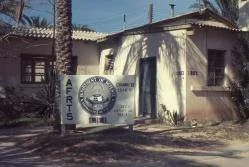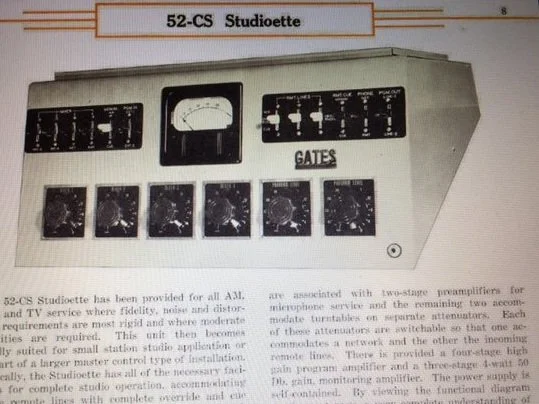RADIO AND TELEVISION.
David Moore- presenting at the Armed Forces Radio and Television Station at Wheelus in the 1960s.
Exterior of Armed Forces Radio and RV Station, Wheelus AB, 1960s
Photo Shared by SunnyLee Grabert.
Wheelus radio station began broadcasting in 1954 on the 990 AM frequency at 100 watts, and was transmitted throughout the base and the surrounding areas of Tripoli. By 1956 the station was operating at 1kw of power, ten times its previous capacity1. This increased capacity gave a much increased signal radius of 23-60 miles2.
Gates Studioette Board
From Gates Gates Studioette Console 1962 User Manual, Public Domain
The studio was equipped with a Gates Radio Board, named the Studioette, which is a single channel monophonic console.
During the weekdays the station was run on an adult basis, with regular information announcements, informing staff, crew and dependents of upcoming hospital clinics, foreign language classes, club activities and military drills. Music was a regular feature, but was heavily censored, so as to not offend the Libyan nationals, who could receive the signal on their own equipment.
By the early 1960s the radio station was on air from 6am until midnight, with a wide variety of programmes3. The base wives ran a rotational afternoon radio show, called the ‘Woman's Day Show’ offering tips and advice. The Wheelus High School Students had their own Saturday morning show, called ‘Here Come the Teenagers’, which was music based and was very popular with the younger dependents4.
FOOTNOTES.
Swenson, M. (n.d.). ALLIED ARMED FORCES(ETC.) RADIO STATIONS. Fr.Svenn homepage. Retrieved August 14, 2022, from http://www.stellamaris.no/afrs.htm
Ibid.,
Ibid.,
Wheelus Air Base, Tripoli, Libya. Facebook. (n.d.). Retrieved August 14, 2022, from https://www.facebook.com/WheelusAirBaseTripoliLibya
Elfotaysi, J. M. (1996, January 1). The development and structure of Libyan Television Broadcasting, 1968-1995. British Library EThOS - Search and order theses online. Retrieved September 20, 2022, from https://ethos.bl.uk/OrderDetails.do?uin=uk.bl.ethos.411278
Libya: Broadcats Television Stations and Channels. BroaDWcast. (n.d.). Retrieved September 20, 2022, from https://broadwcast.org/index.php/Libya
Elfotaysi, J. M. (1996, January 1). The development and structure of Libyan Television Broadcasting, 1968-1995. British Library EThOS - Search and order theses online. Retrieved September 20, 2022, from https://ethos.bl.uk/OrderDetails.do?uin=uk.bl.ethos.411278
WHEELUS TELEVISION STATION
The broadcast was in English and was on air for approximately 5 hours a day, from 6pm-11pm. To allow broadcast, the desk of the news anchor was required to display both the Libyan and the U.S. flag.
After being on air for six months, the station then began to host an hour of Arabic language broadcasts. This began with 15 minutes of government broadcasts, followed by 25 minutes of music, and ending with various shows deemed suitable for Libyan society. This ruled out many of the American and English light entertainment programmes, or films, due to their representing a lifestyle where people consumed alcohol and indulged in sexual relations before marriage, both of which are forbidden by the Islamic religion. The programmes classed as acceptable viewing, were usually wildlife documentaries and science related programmes7. The majority of programmes for base viewing were de-commercialised American and English repeats of comedy shows, sitcoms, dramas, cartoons and movies.
By the early 1960’s the Wheelus T.V. station was broadcasting from 4pm until midnight, with enhanced viewing hours at weekends. 'New' films were usually broadcast approximately 18 months behind the original U.S or English screenings.
Wheelus Television Station began broadcasting from the same broadcasting station building as Wheelus radio on the 15th September 1956, with a transmission power of 5 kilowatts5, making it one of the first stations to transmit within the Arab states.However, due to the lack of televisions available in Libya and the expense entailed in purchasing from Europe, it was only the very wealthy who were able to view the channel6.





